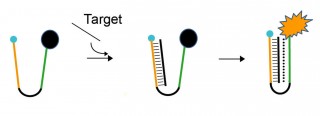May 7 2014
An international research team has built molecular “clamps” out of DNA that offer a powerful new tool for identifying individuals with an increased risk of cancer. The clamp is capable of detecting genetic mutations, associated with cancer and other genetic diseases, with better specificity and affinity than more traditional techniques.
The high affinity of the clamp for its target and the ability to add a fluorescent label that lights up when the clamp grabs the errant DNA sequence, make these new DNA clamp nanoswitches the state-of-the-art in highly-sensitive molecular diagnostics.
 The nanoswitch binds to the DNA target, resulting in the clamp closing and activating the fluorescent signal (orange). Credit: Francesco Ricci, University of Rome, Tor Vergata.
The nanoswitch binds to the DNA target, resulting in the clamp closing and activating the fluorescent signal (orange). Credit: Francesco Ricci, University of Rome, Tor Vergata.
The international team includes NIBIB grantee Kevin Plaxco, Ph. D., University of California, Santa Barbara and his colleagues at the University of Rome in Italy and the University of Montreal in Quebec, Canada. The work is described in the December 2013 issue of the American Chemical Society Journal ACS Nano.
With the list of cancer-causing genetic mutations increasing every day, these bioengineers envision that an individual’s DNA could be screened for known cancer-causing mutations long before the development of disease. With this type of early identification, it may be possible for high-risk individuals to change lifestyle habits known to increase cancer risk. In the future, as the molecular basis for certain cancers is revealed, medications could be developed that inhibit or block the process of cancer formation before it even begins.
How does it work?
DNA exists naturally as two complementary strands known as a double helix, which separates into single strands when heated. Existing DNA-based diagnostic tools consist of a single strand of DNA that binds to one strand of the patient’s heated DNA to form a double helix. However, the new DNA clamp has a powerful vice-like grip that grabs both sides of a patient’s heated, single stranded DNA to form a triple helix -- one DNA strand of the patient’s surrounded by the clamp’s 2 DNA strands. The triple helix creates a bond that is 200-times stronger, and 10-times more specific than a double helix. The superior grip of the DNA clamp nanoswitch enables it to firmly bind to the smallest cancer-causing genetic changes, known as single point mutations. The new method has the ability to identify single point mutations in patient DNA samples with significantly increased specificity, offering much more consistent and reliable identification of mutations than is possible with the systems currently in use. The DNA clamp nanoswitch can be engineered to carry a molecule that lights-up when the clamp snaps shut on the target DNA, clearly indicating the presence of the mutation.
Co-author Francesco Ricci, Ph.D., Laboratory of Bionsensors and Nanomachines, Rome, elaborates: “The advantage of our fluorescence clamp is that it allows distinguishing between mutant and non-mutant DNA with much greater efficiency than other detection methods. This information is critical because it tells patients which cancers they are at risk for or already have. Identifying potential cancer-causing mutations with confidence requires the engineering of a highly accurate and reliable system.”
Dr. Plaxco goes on to explain the basis for the clamp’s efficiency: “Usually, any improvement in affinity is coupled with a reduction in specificity. For example, receptors that bind to their intended target more tightly often also bind to the wrong target more tightly as well. By bringing in additional recognition elements (the second strand of the clamp that forms the triple helix) the DNA nanoswitch improves affinity without sacrificing specificity. To me, that’s the critical lesson here.”
Brenda Korte, Ph. D., the NIBIB Program Director for Sensors and Microsystems stresses the broader significance of the technology: “In addition to the identification of genetic mutations, this work has great potential for numerous new applications of DNA-based nanostructures. The clamp has the potential to be a valuable component for DNA-directed construction of a range of nano-machines including biosensors, and molecular motors. Ultimately, such nano-devices could have a major impact on many aspects of healthcare in the future. This is precisely the type of research NIBIB aims to support – new technologies that have direct applications to a specific problem, but also serve as new, innovative approaches that can be applied to other challenging biomedical issues.”